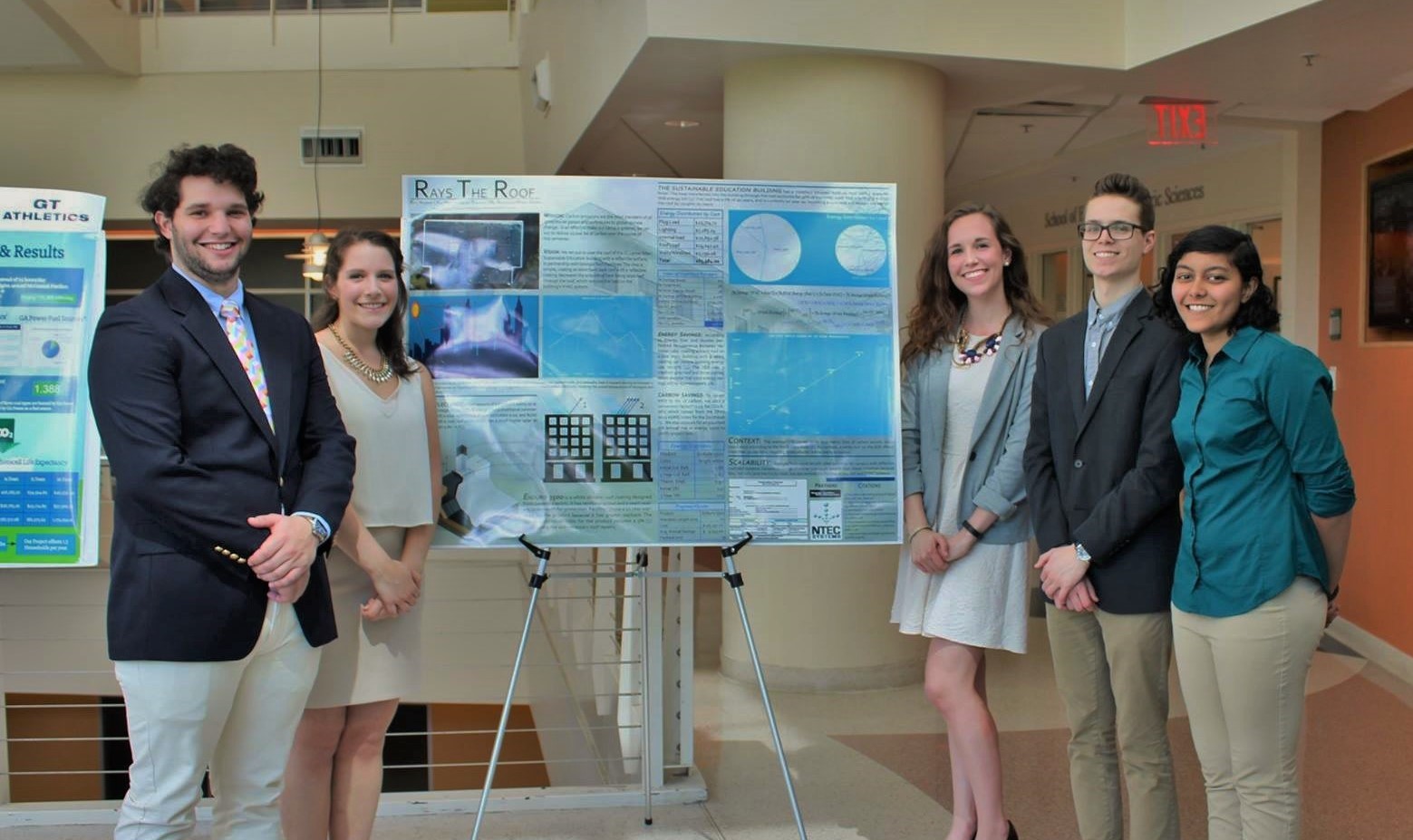Undergrads Help Save Money and Reduce Georgia Tech’s Carbon Dioxide Emissions

Many years from now, when five current undergraduate students revisit Georgia Tech as alumni, they can point to a building on campus and say, “I helped make that building more environmentally friendly.”
These students devised a way to reduce the building’s carbon footprint while meeting a requirement for an undergraduate course. Their project, developed over the course of one semester, has received funding from Georgia Tech and will be implemented.
Carbon dioxide emissions are altering many aspects of the global climate system, posing a variety of risks to society, says Kim Cobb, a professor in the School of Earth and Atmospheric Sciences (EAS). However, slowing the rate of global CO2 emissions has proven difficult. According to recent data from the Environmental Protection agency, the U.S. alone emitted 5.6 billion metric tons of the gas in 2014, about 9 percent more than in 1990. The recent Paris Agreement — which sets out a plan to limit global warming by controlling greenhouse gas emissions — was signed by 197 countries but ratified by only 18.
According to Cobb, relatively modest changes in energy demand add up to significant CO2 emissions reductions in the long term. In the undergraduate course EAS 3110, entitled “Energy, the Environment, and Society,” she challenges students to develop projects during the semester that will reduce real-world carbon footprints.
In the past seven years, winning projects from the course’s “Carbon Reduction Challenge” have resulted in aggregate reductions of about 2,100 metric tons of CO2, according to Cobb. “That’s roughly equivalent to the annual carbon footprints of 100 Americans,” she says.
Cobb requires that proposed projects offset or avoid at least 20,000 lbs, or about 9 metric tons, of CO2 emissions. Projects proving the largest CO2 reductions are selected as winners of the challenge.
This year’s winning group consisted of Ruchi Aggarwal, Kyle J. Hamilton, Janet L. Ploussard, Max B. Rosenbaum, and Marissa N. Snyder. Their project, called “Rays the Roof,” involved retrofitting the roof of the O. Lamar Allen Sustainable Education Building (SEB) with a white, reflective material, which reduces the amount of heat the building absorbs.
At a cost of $49,000 to implement, Rays the Roof would reduce the building’s CO2 emissions by approximately 453 metric tons over the next 20 years, according to the team. The project will also extend the lifetime of SEB’s roof by 10 years and yield savings of $59,000 on the cost of electricity over 20 years, the team calculated.
If the project is successful, similar retrofits may be implemented on other campus buildings, says Mark L. Demyanek, assistant vice president for operations and maintenance at Georgia Tech’s Facilities Management.
Developing a plan to satisfy the requirements took much more time and effort than the group anticipated. The team needed precise calculations on potential energy and money savings, primary sources to support their claims, and exact wording in their final proposal. Group members working on separate portions of the project collaborated throughout the entire semester.
“I didn’t realize how much time it takes to meet with contractors, Georgia Tech facilities employees, product sales representatives, and all others who were a part of making this project happen,” says Snyder, the third-year biology major who initially proposed the white-roof idea.
Rays the Roof received funding through Georgia Tech’s revolving green fund, which is administered by Facilities Management. According to Demyanek, the fund is devoted to executing energy conservation and sustainability projects developed and vetted by Facilities Management, including projects proposed by Cobb’s students over the past two years.
Demyanek says the fund was established in 2012 to support projects and construction practices that advance Georgia Tech’s vision for a greener future. To that end, SEB was fitted with multiple energy-monitoring devices upon its completion in 1997. The abundance of data from these monitors made SEB the perfect candidate for the Rays the Roof project.
Federico Del Risco, a Facilities Management mechanical engineer, assisted the students throughout, ensuring that proper research was completed, calculations were correct, and key language was included in their final proposal. “The Rays team came to us with a really good idea,” he says. “After we reviewed their numbers and technical feasibility, it was just a matter of providing the proper guidance for them to shape the project into a suitable format for requesting funds.”
Along with the distinction of having their project funded, each year’s winner of the carbon challenge goes to Washington, D.C., to discuss their projects with staffers who work for Georgia’s congressional representatives.
“Some of the people we met with were very intrigued by our project because they never realized that something as simple as a white roof could save so much energy in the long run,” says Aggarwal, a first-year mechanical engineering major. “With the growing emphasis on green initiatives in Washington, and the ease with which our project could be implemented, our idea excited several staffers,” she adds.
"The Congressional staffers enjoyed hearing about the winning team’s project,” says Robert Knotts, Georgia Tech's director of federal relations. “More importantly, the students learned a lot about how science and engineering can influence policy.”
That is precisely Cobb’s goal in rewarding the winning groups with trips to Congress. “The students have shown how much can be achieved through thoughtful individual and collective action, but that is no substitute for meaningful climate policy,” Cobb says. “I hope my students recognize that and feel inspired to identify solutions to our carbon problem, wherever their careers take them.”
Matt Barr
Science Communication Intern
School of Earth and Atmospheric Sciences